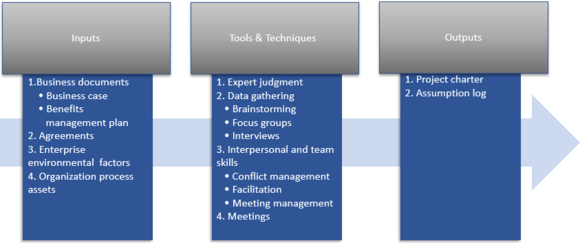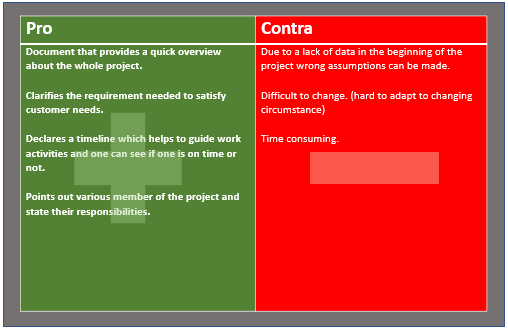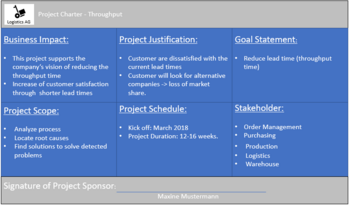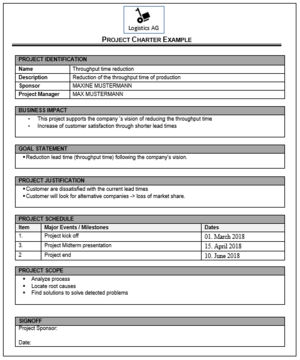The Project Charter
(→Importance) |
(→Timing) |
||
| Line 12: | Line 12: | ||
The purpose of the Project Charter is assigning authority to the project manager to conduct the project. It enables the manager to allocate resources to the project. Additionally, that means the project itself gets formally authorized and is ready to be kicked off. <ref name=''PMP''> '' "PMP Exam Cram: Project Initiation" retrieved, 20.02.2019, from http://www.pearsonitcertification.com/articles/article.aspx?p=102300&seqNum=2 '' </ref> | The purpose of the Project Charter is assigning authority to the project manager to conduct the project. It enables the manager to allocate resources to the project. Additionally, that means the project itself gets formally authorized and is ready to be kicked off. <ref name=''PMP''> '' "PMP Exam Cram: Project Initiation" retrieved, 20.02.2019, from http://www.pearsonitcertification.com/articles/article.aspx?p=102300&seqNum=2 '' </ref> | ||
| + | |||
| + | === Importance === | ||
| + | |||
| + | Using the Project Charter is of special importance for Project Management for the following three aspects: | ||
| + | # The Project Charter ensures that the needs and requirements of the project initiator are understand by the project manager. | ||
| + | # The Project Charter gathers all necessary information to kick off the project. | ||
| + | # The Project Charter serves as a reference document which ensures that everyone connected to the project (e.g. Stakeholder, team member) have the same understanding about the project. A steakholder is an entitiy who has interest in the project or is influenced by it. <ref name="importance"> '' "Importance and Benefits of The Project Charter" retrieved, 20.02.2019, from https://www.knowledgehut.com/blog/project-management/importance-and-benefits-of-the-project-charter/'' </ref> For information about how to identify stakeholders see the article "[[Stakeholder Management]]". | ||
| + | |||
| + | It is essential for project success to have a description of the project. Thus, assembling a Project Charter supports the chance of the project manager to ensure a successful project. <ref name="pracmatic"> '' "Pragmatic Project Management: Five Scalable Steps to Success" written by David Pratt and David Pratt PMP'' </ref> | ||
| + | |||
=== Timing === | === Timing === | ||
Revision as of 19:52, 4 March 2019
Contents |
Abstract
To make a decision whether to initiate a project and to keep an overview over it can be hard for management. This article discusses a tool that helps to take care of the problem following the Project Management Standart published by the Project Management Institute(PMI). It is a powerful document for project management which is created to initiate a project. Even before the planning of the project begins, the charter is assembled once and is acknowledged by the initiating entity like a project sponsor. Due to the fact that the project sponsor signs the Project Charter, the document is hard to change. Project Charters can be crucial for choosing the right project, because it shows a frame of the project and thus helps the management to decide to initiate the project or to choose a different one. Through this charter the project owner, like a project manager, gets permission to kick off the project and is able to apply resources to the project. Hence, the project manager gets a better understanding of the project purpose, project objectives, project expectations and about potential participants. Consequently, the manager can allocate project resources more efficiently. Although a Project Charter is helpful for all projects, the content included in the charter can vary depending on e.g. the project size, project scope or project complexity. [1]
The following article discusses the content and definition of the charter in more depth and hence provides a guide how to develop such a charter. Moreover, it discusses when to use it and points out pros and cons of the Project Charter. In addition, an example of the real business world is provided and explained.
Introduction to Project Charter
The Project Charter is a document that formally acknowledges the existence of the project. Referring to the PMBOK® Guide, a worldwide acknowledged standard for project management developed by the Project Management Institute (PMI), the charter assigns the authority over the project to the project manager from the project initiator. The acknowledgement can be done by a signature of the project sponsor.[2]A project sponsor is a person or entity who is able to assign recources and authority to the project manager. Wheras the project manager uses tools and knowledge to lead and manage the project.[3] Once the document is approved the charter should not be changed. In addition, there is no certain way a Project Charter should look like and it is not set in stone which topics it mandatorily has to include. The extend of the charter's content can vary because it depends on the information known at the time of creation and on the complexity of the project itself. However, a high-level Project Charter ensures a common understanding about key deliverables, milestones, roles and responsibilities of everyone engaged in the project. The content will be discussed in more detail in section "Content". Such a document should be created no matter how big or small the project seems to be, because it provides a general overview about the project.[4] The result is, that there is a general understanding of the project which helps to allocate resources more efficiently. [1]
Purpose
The purpose of the Project Charter is assigning authority to the project manager to conduct the project. It enables the manager to allocate resources to the project. Additionally, that means the project itself gets formally authorized and is ready to be kicked off. [5]
Importance
Using the Project Charter is of special importance for Project Management for the following three aspects:
- The Project Charter ensures that the needs and requirements of the project initiator are understand by the project manager.
- The Project Charter gathers all necessary information to kick off the project.
- The Project Charter serves as a reference document which ensures that everyone connected to the project (e.g. Stakeholder, team member) have the same understanding about the project. A steakholder is an entitiy who has interest in the project or is influenced by it. [6] For information about how to identify stakeholders see the article "Stakeholder Management".
It is essential for project success to have a description of the project. Thus, assembling a Project Charter supports the chance of the project manager to ensure a successful project. [3]
Timing
The Project Charter is created during the Initial Project Phase of the Project Lifecycle (see Figure 1: Phases of Project Management). Beginning with initiating the project the needs and wants of the project are identified. This is done by developing and gathering the information belonging into the Project Charter.[1] How a Project Charter is developed is explained in the section "Developing a Project Charter" later in this article.

The red arrow indicates the point in the project where the Project Charter should be assembled.
Developing a Project Charter
This chapter provides knowledge about the way a Project Charter is being developed. It consists of three steps named Input, Tools and Techniques and Outputs (see Figure 2: "Developing a Project Charter" in section "Input"). Benefits of the process are that it directly links the project with the strategic objectives of the initiating entity, providing a coherent overview of the project and moreover it emphasizes the commitment of the project sponsor/ initiating entity.[1]
Input
1. Business Documents

- Business case: Provides information perceived from the business point of view. Hence, it determines whether the expected project outcomes justify the project investment. It often contains cost benefit analysis and consider companies.[1]
- Benefit Management Plan: Is a document that states how and when benefits of the project will be delivered. A benefit is defined as an project outcome that creates value to the sponsoring entity of the project. [1]
2. Agreements
Are used to define the initial intentions of the project. It supports the alignment within the project. Can be formalized in form of a contract.[1]
3. Enterprise environmental factors
Consider all environmental factors can influence the development. Examples are the market place conditions, the legal and regulatory requirement and constrains and industrial as well as government standards.[1]
4. Organization process assets
Consider internal functions and standards of the performing company. Organizational policy can influence the process of developing a Project Charter as well as internal processes and procedures. For example, organizations tend to differ from the way how decisions are made and thus reflects on developing the Project Charter.[1]
Tools and Techniques
1. Expert Judgment
Is known as a judgment made based on the experiences on has earned in a specific area, industry, knowledge area. Areas of expertise can be for example business analysis, diagram techniques or conflict management.[1]
2. Data Gathering
To gather ideas or data to conduct evaluation on they have to be gathered in the first place. Tools to gather data are the following:
- Brainstorming: Is a creativity technique to gather ideas. Commonly it is done in a group environment and does not require a lot of time to conduct. In that group environment ideas get collected from each participant. At the end off this intence session all ideas has to be discussed and prioritized.[7] For more detailed information see the article "Effective Brainstorming".
- Focus groups: Focus groups bring together prequalified stakeholders and subject matter experts to learn about their expectations and attitudes about a proposed product, service, or result. A trained moderator guides the group through an interactive discussion designed to be more conversational than a one-on-one interview.
- Interviews: An interview is a conversation with two parties where questions are asked, and answers are giving. It is used to gather information. For example, it might be necessary to have an interview with the stakeholders to get more information about constrains or approval criteria.[1]
- Survey: A survey is used to gather data from a sample of people. Predefined questions are asked either face to phase, asked via telephon calls to the participant or the person has to fill out the questionair on paper or digitalized. [8]
3. Interpersonal skills
- Conflict Management: Is the practice of identifying and dealing with conflicts fairly and efficiently. [9] Can be used to solve conflicts for example between stakeholder and the Project Charters content. Using the skill helps to align the stakeholder with for example the success criteria or project objectives stated in the Project Charter. Properly used conflict management can have a positive influence on the overall group outcome.[10]
- Facilitation: This interpersonal skill enables to effectively guide an event. The facilitator (person who guides the meeting) takes care of that all participants get a mutual understanding, that there is good participation and that all suggestions are taken into consideration. [1]
- Meeting Management: Ensures a proper planning of the meeting. That means that the agenda is well prepared and most importantly that the right representatives for each stakeholder group are invited. [1]
4. Meetings
This process includes the meeting with the stakeholder to clear the project details. Information like for example the objectives, success criteria and deliverables are discussed. [1]
Outputs
The outputs of the process are following documents:
1. Project Charter
The output is the Project Charter which is the document that transfer authority over the project to the project manager. The document initiates the project and the project manager is enabled to apply organizational resources on the project.
2. Assumption log
The assumption log records all assumptions and constrains during the whole project lifecycle. [1] It is important to understand under which conditions the Project Charter had been created.
Content
The Project Charter can include following information:
- Goal Statement: A brief description of the project objectives
- Executive Summary: States a brief description of the project
- Approach: Is a statement of tenets the project team will follow
- Scope: States the scope of the project. Clears what is in the scope and outside the scope of the project.
- Project Justification: Explains why the project is important and points out benefits.
- Constrains: State the limits of the project. (e.g. Budget, Legal, Environmental)
- Organization: Mentions the members of the project and in addition state which area of the company they represent.
- Completion Criteria: Includes the criteria about when the project can be seen as completed.
- Success Criteria: Defines the conditions under which the project will be seen as a success.
- Schedule: Sets the time frame of the project and contains a start and end date. Hence, milestones can be determined and brought into account.
- Assumptions: States which assumptions are made in developing the Project Charter. Furthermore, it can be stated what impact a failure of the assumption has on the project.
- Impacts: Identifies the impact of the project on other parts of the company.[4]
- Risks: State possible risk that might lead to a failure of the project.
- Project Stakeholder: States entities that have interest in the project (e.g. Stakeholder, Sponsor, Team member)
- Approval: States name the name of the person (e.g. authority or project sponsor) who authorizes the Project Charter.
- Project Manager: Points out the name of the person who is authorized to lead the project.
- Preapproved Financial Resources: States authorized financial resources accessable for the project.[1]
It has to be emphasized again that the Project Charter has no certain layout and depends on the information given. For this reason, the content of the charter can vary from charter to charter.[1]
Pros and Cons
The next figure provides an overview about the Pros and Cons of the Project Charter. (see Figure 3: Pros and Cons)
As one can obtain from the figure one of the benefits of the Project Charter is that it provides a quick overview about the project and clarifies the needs of the project initiator/sponsor. Thus, going into the next phase of the project, the planning phase, can be done more structured and more efficiently. Furthermore, it provides a certain timeframe which helps to see if the project is on track or not. In addtion, it clarifies which the resposibilities are for everyone involved so that everyone knows what to do and whom to ask in case of questions. [11] On the other hand, creating a proper Project Charter requires time to evaluate and gather information. Hence, once the Project Charter is created it is hard to change so that some unpredicted occurances during the project can not be properly included to the charter.[4] A project manager can not predict everything that influences the project in advance. As a result the assumptions made in the Project Charter can turn out wrong. Additionally, the environment of the project can change so that the assumptions are not valid anymore and the changes are hard to be implemented in the Project Charter. [1]
Example of a Project Charter
Example one
The figure four illustrates how a Project Charter can look like. Due to the fact that the article emphasizes that the there is no clear rule how the charter should look like and which content should be included one can be creative. [1] The example should help to get an idea how a charter can look like. Important information had to be made unrecognizable (therefore the black boxes).
The Project Charter was assembled to kick off a project for bachelor students at a big German company. For this reason, the project manager (leader)as well as the sponsor, stakeholder and team member are identified. Hence, the charter states what kind of impact the project (Business Impact) has, why the project is initiated (Project Justification) and what the goal of the project is (Project Goal). For the information what the meanings of each area is please view chapter "Content". In addition, the project scope is clearly set as well as a certain timeframe in which the project should be conducted. To make the charter look professional the logo of the company can be substituted with the box "Business Logo". For the authorization the project sponsor has a field where he can sign.
Example two
Figure number five illustrates another possible solution to design a Project Charter. The same information is used as in the previous example. Both examples just differ from the layout. Free templates for Project Charters can be found here Project Charter Templates.
Conclusion
The Project Charter is a useful tool to initiate the project in a structured manner. It serves the function to assign authority to the Project Manager thus he is enabled to transfer resources to the project. Since the Project Charter contains an overview of the project it ensures that every person involved is on the same page. Furthermore, it sets a timeframe to the project so that the Project Manager can see if the project is on time or not. In addition, the Project Manager can always refer to the project along during the hole duration of the project and knows what the requirements are to satisfy the needs of the sponsor. To develop the charter the Project Manager can follow certain steps named Input, Tools and Techniques and Outputs. Besides the advantages the charter has also drawbacks. A proper charters needs time to assemble and once it is approved from the project sponsor it is hart to change. Thus, adaptions to changes in the project are hard to report in the project charter.
All in all, the Project Charter is important for Project Management to introduce a project in a structured manner and to provide an overview of the project so that the the project can be conducted more efficiently. The Project Charter is suitable for every project size.
Annotated Bibliography
Project Management Institute. A Guide to the Project Management Body of Knowledge (PMBOK® Guide) - sixth edition. This book contains the latest version of Project Management standarts. Thus, management tools and guidance are provided in detail and easily to comprehend. The book dedicates a whole chapter to the Project Charter and exermines all aspects like Project Charter development and content. The book provides detailed information and is well written.
A practical guide to project management written by David A. Grootenhuis. This book provides a good overview what a Project Charter is about and how to use it. Moreover, the book describes the content of the Project Charter in detail, which helps to undertstand the whole charter well in relation to the business environment. Hence, the book is well structured thus it is easy to find the information one is looking for.
References
- ↑ 1.00 1.01 1.02 1.03 1.04 1.05 1.06 1.07 1.08 1.09 1.10 1.11 1.12 1.13 1.14 1.15 1.16 1.17 1.18 1.19 1.20 "Guide to the Project Management Body of Knowledge (PMBOK® Guide)" (6th Edition) retrieved,15.02.2019, from https://app-knovel-com.proxy.findit.dtu.dk/web/toc.v/cid:kpGPMBKP02/viewerType:toc/root_slug:viewerType:toc/url_slug:root_slug:guide-project-management?kpromoter=federation
- ↑ PMBOK® Guide and Standards retrieved ,20.02.2019, from https://www.pmi.org/pmbok-guide-standards
- ↑ 3.0 3.1 "Successful Project Sponsorship: A Time-Saver for the Busy Executive" written by Michiel van der Molen (2015)
- ↑ 4.0 4.1 4.2 4.3 4.4 "A practical guide to project management" written by David A. Grootenhuis (2001)
- ↑ "PMP Exam Cram: Project Initiation" retrieved, 20.02.2019, from http://www.pearsonitcertification.com/articles/article.aspx?p=102300&seqNum=2
- ↑ "Importance and Benefits of The Project Charter" retrieved, 20.02.2019, from https://www.knowledgehut.com/blog/project-management/importance-and-benefits-of-the-project-charter/
- ↑ "Top 100 Management Tools: Das wichtigste Buch eines Managers" written by Schawell and Billing (2011)
- ↑ "Data Gathering Tools" retrieved ,20.02.2019, from https://learningspacetoolkit.org/needs-assessment/data-gathering-tools-2/index.html
- ↑ "What Is Conflict Management? - Definition, Styles & Strategies" retrieved ,20.02.2019, from https://study.com/academy/lesson/what-is-conflict-management-definition-styles-strategies.html
- ↑ "Definition Conflict Management" retrieved ,20.02.2019, from http://www.businessdictionary.com/definition/conflict-management.html
- ↑ 11.0 11.1 "8 Key Benefits of A Project Charter" retrieved, 20.02.2019, from http://www.project-skills.com/8-key-benefits-project-charter/


